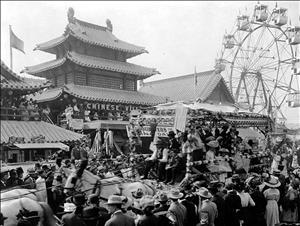The Chinese Village was built for the Alaska-Yukon-Pacific (A-Y-P) Exposition in Seattle in 1909. The exposition took place between June 1 and October 16, 1909, drawing more than three million people. Visitors came from around the state, the nation, and the world to view hundreds of educational exhibits, stroll the lushly manicured grounds, and be entertained on the Pay Streak midway, while Seattle promoted itself as a gateway to the rich resources of Alaska, the Yukon, and Asia. The development and management of the Chinese Village was handled by Ah King (1863-1915), a successful Chinese merchant in Seattle. It was located in the northern part of the Pay Streak, right next to the Ferris wheel, and featured three buildings, including a Chinese temple, a restaurant, and a theater with acts that changed daily.
It Takes a Village
Both citizens of China and Chinese Americans living in the Northwest (as well as the rest of America) at the beginning of the twentieth century faced considerable hostility from non-Asian people, many of whom were themselves immigrants. Many thousands of Chinese had immigrated to the United States during the nineteenth century, most of them unskilled laborers who competed for jobs with non-Asian workers. By the 1880s hostility against the Chinese became so intense that Chinese laborers, including those in Washington state, were often attacked and expelled from their communities. The Chinese Exclusion Act of 1882, which restricted Chinese immigration to the United States, only underscored this sentiment, which continued well into the twentieth century.
It was against this backdrop that the Chinese living in Seattle in early 1900s began to prepare for the Alaska-Yukon-Pacific Exposition in Seattle in 1909. Unlike many other countries who participated in the A-Y-P, the Chinese government did not sponsor its exhibit or otherwise officially participate in planning its exhibit at the fair, although Goon Dip (ca. 1862-1933), honorary consul for the Chinese government, raised money on his own initiative and obtained some of the fair’s exhibits from his Chinese contacts living in Seattle, Portland, and San Francisco. Instead, the roughly 800 Chinese living in Seattle in 1909 helped finance the construction and management of what became known as the Chinese Village at the A-Y-P. Virtually all of the Chinese living in the region as the fair approached were said to have contributed $4 each (nearly $80 in 2009 dollars) toward the construction of the Chinese Village.
Ah King, a particularly successful businessman in Seattle’s Chinatown (he was variously known as the “mayor” or “king” of Chinatown), played a central role in the development and management of the Chinese Village. He traveled to China in December 1908 on a six-month expedition to choose Chinese goods and curios to be exhibited in the Chinese Village, and also retained actors from Shanghai to appear in the Chinese theater during the four and a half months the fair was underway. (He was in China in early 1909 when the village was being built, and his assistants -- particularly one Shin How -- handled the construction preparations.) Ah King also negotiated an agreement with exposition officials shortly before the fair opened in June 1909 to pay a flat rate of $3,000 plus 25 percent of receipts from the main gate to enter the Chinese Village. The exposition furnished a ticket-taker to collect the admission to enter the Chinese Village (the admission fee to enter the village is presently not known, though it cost a dime to enter the Chinese Temple and Theatre). All other sources of revenue generated by the village were controlled by Ah King’s management.
Jugglers, Musicians, and Acrobats
The Chinese Village was located along the southwestern edge of the northern part of the Pay Streak, sandwiched between the Ferris wheel to the north and the Arena to the south. The village consisted of three buildings, which included a bazaar, a Chinese temple (said to have been brought intact from Shanghai), Ah King’s restaurant, and a tea room; the Chinese exhibits and curios were exhibited on the village grounds behind the main building. It cost about $15,000 to build the buildings, and the cost to shuttle approximately 20 persons from China (many of them the theatrical troupe) to work at the A-Y-P (and back to China afterward), plus their compensation, was $5,000. Other costs pushed the grand total to build and operate the village past $25,000.
The Chinese Theatre was a favorite attraction at the Chinese Village. It featured performances that changed daily by the Tin Yung Qui Troupe, also billed as the “Pekin” (Peking) Troupe, even though the group actually hailed from Shanghai. The troupe -- said to be direct from the court of the Dowager Empress -- of jugglers, magicians, and acrobats wowed the crowd with their acts; one of the magicians was a woman, not particularly unusual for a Chinese performance in 1909, but most unusual for an American performance. Many of these performers toured the vaudeville circuit for a few months after the exposition ended; eventually most of them returned to China. Ah King’s restaurant, serving authentic chop suey, was also a favorite.
Ah King said shortly before the exposition began that he did not expect to make a profit from the Chinese Village and in fact anticipated a loss. He was right: The village brought in total revenues of $21,451, and this was before the A-Y-P got its cut ($4,863). Still, the Chinese Village didn’t do too badly, bringing in nearly as much revenue as the A-Y-P’s Japanese Village. This was big for Seattle’s Chinese community, not only because the Japanese government sponsored the Japanese Village, but also because there were several thousand more Japanese than Chinese in Seattle in 1909.

